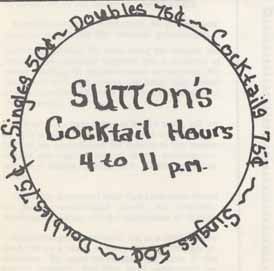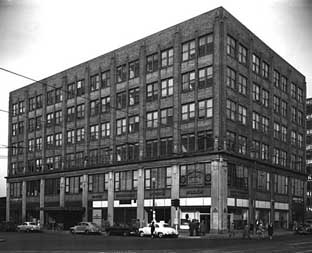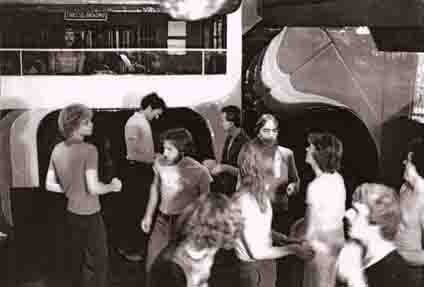Difference between revisions of "Sutton’s Place"
m |
|||
| (10 intermediate revisions by 3 users not shown) | |||
| Line 4: | Line 4: | ||
| − | + | {{unprotected}} | |
{| {{prettytable}} | {| {{prettytable}} | ||
! | ! | ||
| Line 28: | Line 28: | ||
| − | The bar’s dramatic change came when Evelyn Sutton sold the bar to | + | The bar’s dramatic change came when Evelyn Sutton sold the bar to Gordon Locksley, who changed the bar into a gay bar in 1966,<small>(4)</small> Locksley sold the establishment to Ernest "Ernie" Pesis, a former owner of the [[State Bar]] in the [[Gateway District]]. A target for considerable gossip, Ernie was suspected by some to be a member of organized crime; others considered him "a true straight ally" and "a decent and caring individual."<small>(5)</small> Ernie eventually sold Sutton's to his son, Ronnie. |
| <div style="text-align: center;"> | | <div style="text-align: center;"> | ||
| Line 38: | Line 38: | ||
| − | Regardless of ownership, Sutton’s became an immensely popular site for “disco bunnies,<small>(6)</small> or young gay men with a penchant for dancing. Sutton’s grew into other parts of the old bank as time progressed—even to the vaults<small>(7)</small>—and competed with the Gay 90s for a brief period. However, the club’s success didn’t offset | + | Regardless of ownership, Sutton’s became an immensely popular site for “disco bunnies,<small>(6)</small> or young gay men with a penchant for dancing. Sutton’s grew into other parts of the old bank as time progressed—even to the vaults<small>(7)</small>—and competed with the Gay 90s for a brief period. However, the club’s success didn’t offset Ronnie's questionable financial dealings—he eventually sold Sutton’s to “Andy” Anderson and John Moore, and they created [[The Saloon]]. |
| + | |||
| + | |||
| + | <div style="text-align: center;"> | ||
| + | [[Image:Sutton Place dance floor 1976.jpg]] | ||
| + | </div> | ||
| + | <div style="text-align: center;"> | ||
| + | '''<small>The Sutton Place dance floor in 1976. Photo courtesy of Chester Daxe.</small>''' | ||
| + | </div> | ||
| + | ---- | ||
| + | ==This entry is part of:== | ||
| + | == [[Minneapolis/St. Paul, MN: 100 Queer Places in Minnesota History, (1860-2010)]]== | ||
---- | ---- | ||
| Line 50: | Line 61: | ||
<small>(3)</small>Lewin, Rhoda. ''The Jewish Community of North Minneapolis.'' Chicago: Arcadia Publishing, 2001. | <small>(3)</small>Lewin, Rhoda. ''The Jewish Community of North Minneapolis.'' Chicago: Arcadia Publishing, 2001. | ||
| − | <small>(4)</small> City directories, ''Ibid.'' | + | <small>(4)</small> City directories, ''Ibid.'' See also a comment below by "Chdaxe" |
| + | |||
| + | <small>(5)</small> The "organized crime" may be better attached to Enrie's son, Ron: Carlyle, Erin. "Rommal Bennett's Trial Revisits Spate of Gay Murders in the Twin Cities." City Pages, 4/7/2009. http://www.citypages.com/2009-04-08/news/rommal-bennett-s-trial-revisits-spate-of-gay-murders-in-the-twin-cities/ | ||
| − | + | See below comment by "chdaxe" for a positive testament to Ernie's character. | |
<small>(6)</small>Gronseth, Greg. Impromptu conversation with the author, Summer 2009. | <small>(6)</small>Gronseth, Greg. Impromptu conversation with the author, Summer 2009. | ||
| Line 58: | Line 71: | ||
<small>(7)</small>''Ibid.'' | <small>(7)</small>''Ibid.'' | ||
| − | + | ||
| + | |||
| + | =See also: [[Gay Discos]]= | ||
Latest revision as of 21:32, 13 July 2012
Glenwood and Humboldt Ave N.; 5th and Marquette; 7th St. N. and 1st Ave. N., Minneapolis
| Sutton's Ad in the Uptown Voice, 1971. Courtesy of the Jean-Nickolaus Tretter Collection. |
Sutton’s Bar, also known as Sutton’s Place or simply as “Sutton’s,” was a curious meeting place for queer men (and women for a time) in Minneapolis. The establishment was one of few that operated before and after the landmark Stonewall Riots in New York, a national event that affected the Twin Cities’ queer community and their popular haunts.
|
| Sutton’s moved into the old Produce State Bank Building at 7th Street North and First Avenue North in the early 1960s. 20 years before gentrification, the rough area was home to vacating warehouses and cheap wholesalers. Harold and Elizabeth possibly saw business opportunity in the neighborhood, but they likely cared more about cheap rent.
|
The Produce State Bank building in 1959, approximately 10 years before Sutton's relocated to this site. Image Courtesy of the Minnesota Historical Society. |
Regardless of ownership, Sutton’s became an immensely popular site for “disco bunnies,(6) or young gay men with a penchant for dancing. Sutton’s grew into other parts of the old bank as time progressed—even to the vaults(7)—and competed with the Gay 90s for a brief period. However, the club’s success didn’t offset Ronnie's questionable financial dealings—he eventually sold Sutton’s to “Andy” Anderson and John Moore, and they created The Saloon.
The Sutton Place dance floor in 1976. Photo courtesy of Chester Daxe.
This entry is part of:
Minneapolis/St. Paul, MN: 100 Queer Places in Minnesota History, (1860-2010)
(1) According to an inventory of Minneapolis City Directories, in the 4th floor stacks of Hennepin County Central Library in Minneapolis.
(2)Ibid.
(3)Lewin, Rhoda. The Jewish Community of North Minneapolis. Chicago: Arcadia Publishing, 2001.
(4) City directories, Ibid. See also a comment below by "Chdaxe"
(5) The "organized crime" may be better attached to Enrie's son, Ron: Carlyle, Erin. "Rommal Bennett's Trial Revisits Spate of Gay Murders in the Twin Cities." City Pages, 4/7/2009. http://www.citypages.com/2009-04-08/news/rommal-bennett-s-trial-revisits-spate-of-gay-murders-in-the-twin-cities/
See below comment by "chdaxe" for a positive testament to Ernie's character.
(6)Gronseth, Greg. Impromptu conversation with the author, Summer 2009.
(7)Ibid.


